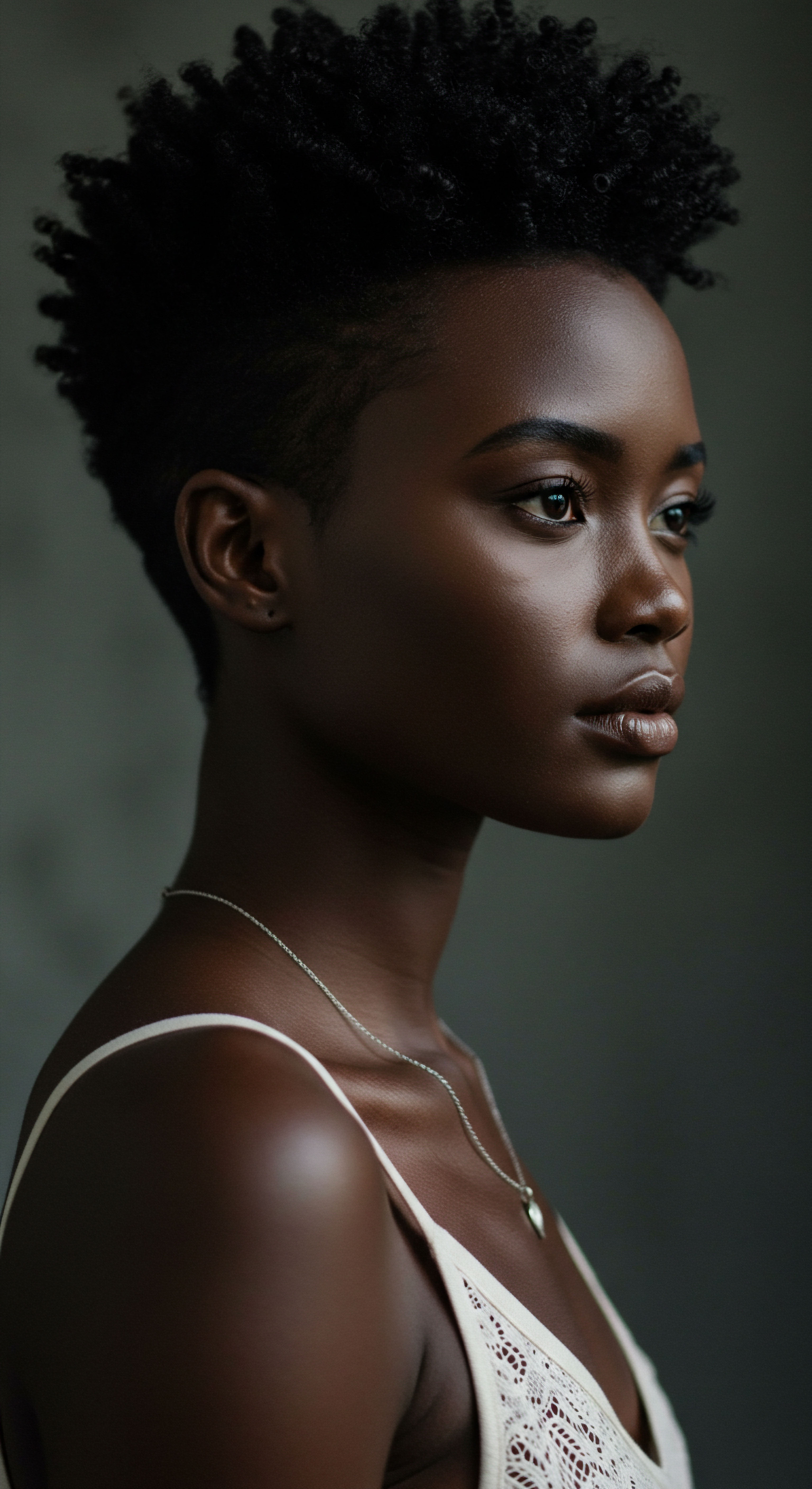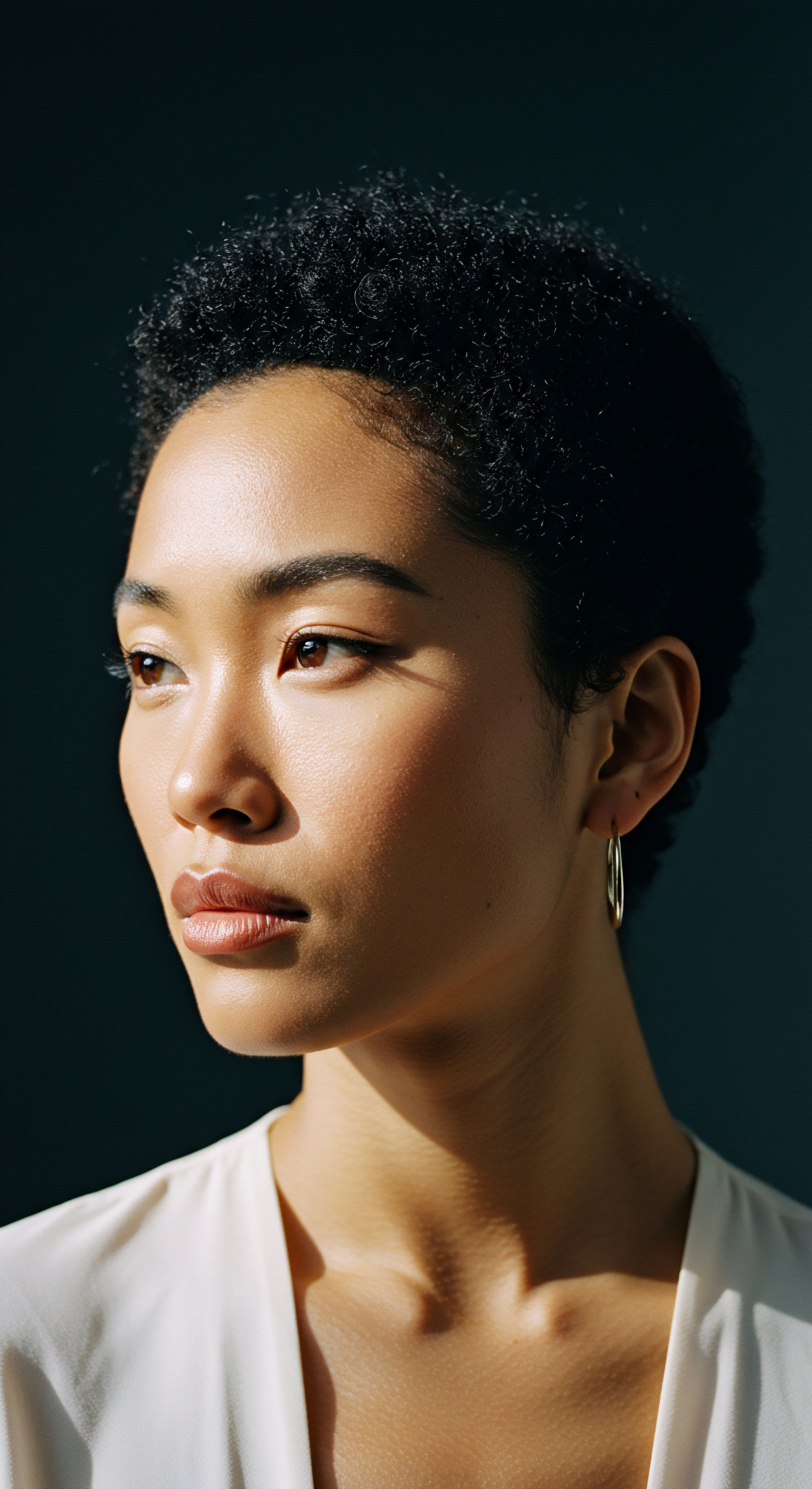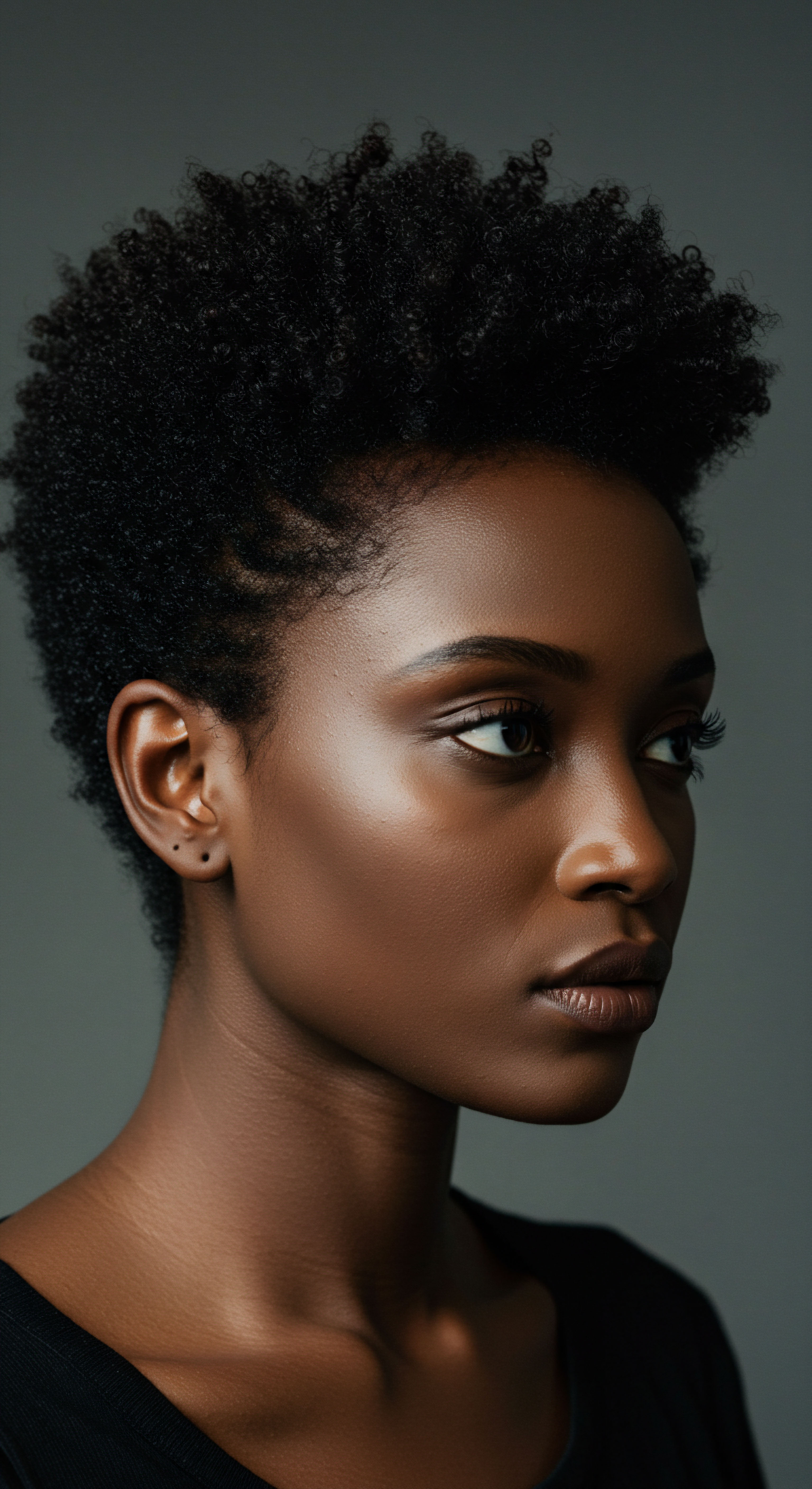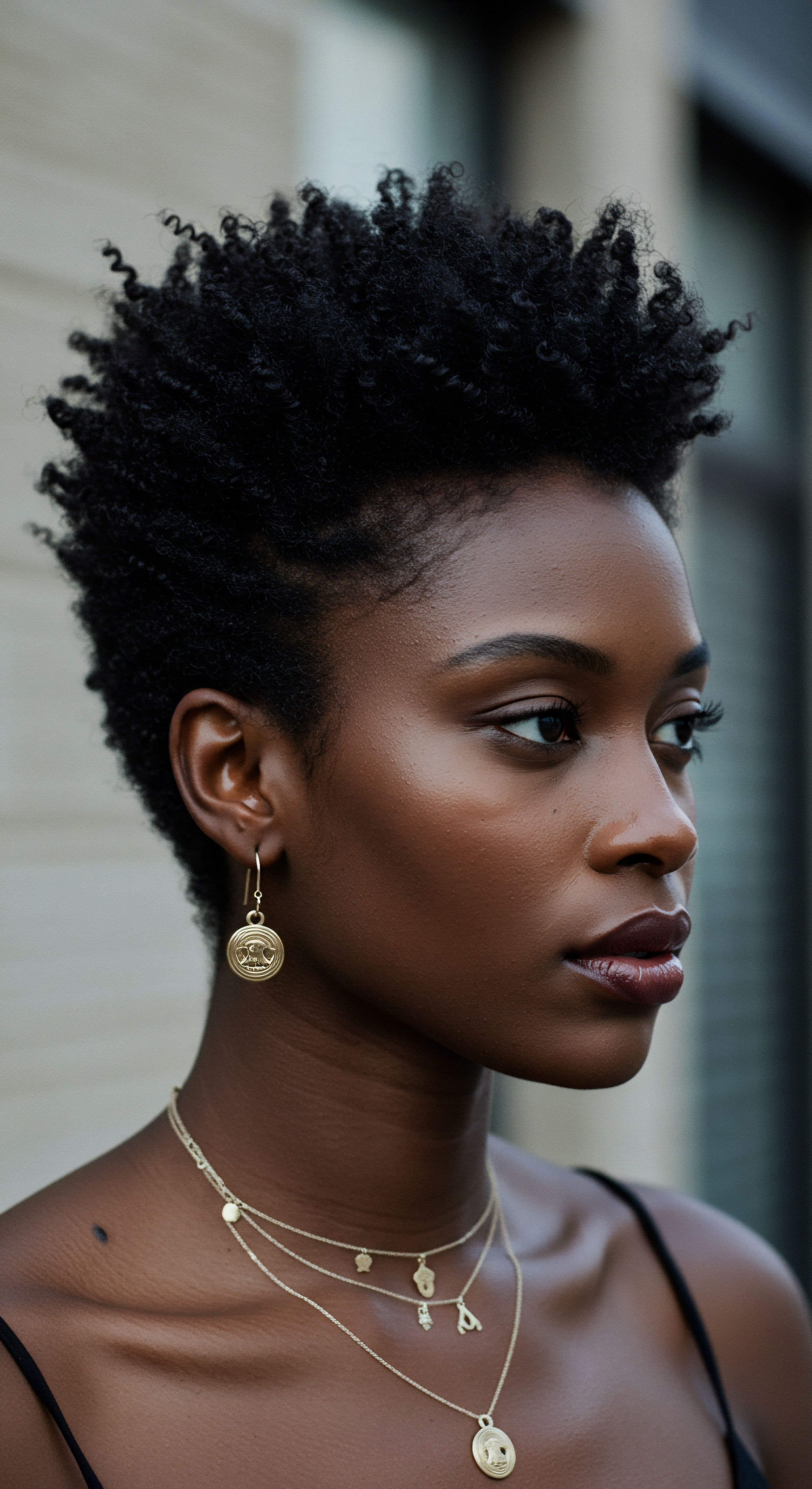
Roots
Beneath the crown of our coils and curls lies a delicate landscape, often shielded, sometimes adorned. We often consider the external beauty of our head coverings, their vibrant hues, or the way they complete an ensemble. Yet, what quiet dialogues transpire between fabric and skin, between the chosen material and the very roots that anchor our strands?
This exploration begins at the very ground of being, seeking to understand the foundational whisperings of our scalp. The materials we choose to grace our heads, whether for protection, tradition, or style, interact with a complex ecosystem residing just beneath the surface, influencing everything from moisture balance to microbial harmony.

The Scalp’s Delicate Environment
The scalp, an extension of our skin, possesses its own unique characteristics. It is home to numerous hair follicles, sebaceous glands producing natural oils, and a diverse community of microorganisms, collectively known as the scalp microbiome. This intricate balance is essential for healthy hair growth and a comfortable scalp.
When this balance is disrupted, discomfort, irritation, or even more persistent issues can arise. The environment created by a head covering directly impacts this delicate ecosystem, acting as a microclimate that either supports or challenges its equilibrium.
Consider the natural secretions of the scalp. Our sebaceous glands produce sebum, a natural oil that coats the hair shaft, providing lubrication and a protective barrier. The skin itself constantly sheds dead cells. When these natural processes occur under a head covering, the material’s properties become paramount.
A fabric that traps heat and moisture can create a warm, humid environment, potentially encouraging the overgrowth of certain microbes or leading to increased oiliness. Conversely, a material that allows for ample airflow helps maintain a balanced temperature and humidity, supporting the scalp’s natural functions.
The scalp, a living landscape beneath our hair, reacts intimately to the materials we choose for its covering.

Understanding Fiber Characteristics
The very fibers that compose our head coverings possess distinct characteristics, each playing a role in their interaction with the scalp and hair. These properties dictate how a material will absorb moisture, regulate temperature, and create friction. For centuries, various cultures have intuitively understood these distinctions, favoring certain natural fibers for their protective and comforting qualities.
- Natural Fibers ❉ Materials like silk, cotton, and bamboo are derived from plants or animals. They often possess inherent breathability and moisture-wicking properties. Silk, for example, is renowned for its smooth surface, which reduces friction on hair, and its ability to retain moisture within the hair itself, rather than absorbing it. A 2020 study notes silk’s hydrating and breathable properties, helping hair avoid dryness and frizz, while also lessening breakage.
- Synthetic Fibers ❉ Materials such as polyester, nylon, and acrylic are manufactured from chemical compounds. While often durable and affordable, their breathability can vary widely. Some synthetic fabrics may trap heat and moisture, potentially leading to a less ideal scalp environment.
| Material Type Silk (Natural) |
| Key Properties Smooth, breathable, moisture-retaining for hair, low friction. |
| Potential Scalp Impact Supports moisture balance, reduces breakage, minimizes irritation. |
| Material Type Cotton (Natural) |
| Key Properties Absorbent, breathable (can absorb scalp's natural moisture), moderate friction. |
| Potential Scalp Impact Can dry out hair and scalp, may cause friction, good for general airflow. |
| Material Type Satin (Often Synthetic Blend) |
| Key Properties Smooth surface (reduces friction compared to cotton), less breathable than silk, can trap heat. |
| Potential Scalp Impact Better for friction than cotton, but may lead to sweating and moisture buildup if not breathable. |
| Material Type Polyester (Synthetic) |
| Key Properties Durable, quick-drying, can be less breathable, may trap heat and sweat. |
| Potential Scalp Impact Risk of heat and moisture accumulation, potential for microbial overgrowth. |
| Material Type Understanding these basic properties is a first step toward making informed choices for scalp wellness. |

Does Fiber Origin Affect Scalp Health?
The distinction between natural and synthetic fibers is more than a matter of feel or cost; it can directly influence scalp well-being. Natural fibers, with their inherent ability to breathe and manage moisture, often permit the scalp to maintain its natural balance. Cotton, while absorbent, allows for significant air circulation, which can be beneficial, though its absorbency can also draw moisture from the hair and scalp. Silk, a protein fiber, behaves differently, offering a smoother surface that minimizes mechanical stress on hair and a less absorbent quality that helps retain the hair’s natural hydration.
Synthetic fibers, by their very nature, can present a different set of challenges. Some, particularly those not designed for athletic wear with advanced wicking capabilities, can create a sealed environment. This occlusion can lead to an increase in scalp temperature and humidity, which in turn can alter the skin’s pH and potentially encourage the proliferation of certain microorganisms.
Research indicates that synthetic clothing can lead to an increase in allergic reactions in some individuals, an effect not observed with natural fiber garments. This suggests a broader biological compatibility of natural materials with human skin, including the scalp.

Ritual
Stepping beyond the fundamental science, we arrive at the realm of daily practices, where head coverings become an integral part of personal ritual and expression. The query of whether material choice can alter scalp health finds its most tangible answers in these repeated gestures of covering and adorning. It is in the rhythm of our lives, the choice of a bonnet for sleep, a scarf for daily wear, or a wig for a new look, that the silent conversations between fabric and scalp truly begin to unfold. This section seeks to provide practical wisdom, guiding choices that honor both personal style and scalp vitality.

The Nighttime Sanctuary ❉ Choosing Sleep Coverings
The hours we spend in slumber offer a unique opportunity for hair and scalp care, or conversely, a period of potential stress if not managed thoughtfully. The choice of sleep covering is particularly significant for textured hair, which is prone to dryness and friction-induced damage. Cotton pillowcases, while common, can absorb moisture from hair, leaving it dry and brittle. They also create friction, leading to tangles, frizz, and breakage.
This is where materials like silk and satin step in, acting as gentle guardians for our strands. Silk, a natural protein fiber, allows hair to glide smoothly, significantly reducing friction. It is also less absorbent than cotton, meaning it helps hair retain its natural oils and moisture.
Satin, often a synthetic blend, also offers a smooth surface that minimizes friction, making it a better alternative to cotton. However, it is worth noting that silk generally surpasses satin in breathability and moisture retention, offering superior benefits for long-term hair health.
- Silk Bonnets ❉ Provide a smooth, low-friction environment, helping to preserve hairstyles and prevent moisture loss. They are especially beneficial for maintaining the hydration of textured hair.
- Satin Bonnets ❉ Offer similar friction-reducing benefits to silk, making them a good, often more affordable, alternative to cotton. They help minimize frizz and breakage.
The quiet hours of sleep are a profound opportunity to nurture scalp health through mindful material selection.

Daily Adornments ❉ Scarves, Hats, and Head Wraps
Beyond the bedroom, head coverings serve myriad purposes in our daily lives, from cultural expression to sun protection. The material choice here carries weight, influencing airflow, temperature regulation, and potential friction throughout the day. For those who wear head coverings for extended periods, such as hijabs or turbans, the implications for scalp health become even more pronounced.
Studies have explored the relationship between head coverings and scalp conditions, though findings can vary depending on the specific context and materials. For instance, a study examining scalp hydration and pH in hijab-wearing women found no statistically significant difference compared to non-hijab-wearing women, provided the head covering was not worn when wet and there were no underlying scalp conditions.
However, the concept of occlusion remains relevant. If a material traps heat and moisture, it can create a microenvironment conducive to sweat accumulation and alterations in the scalp’s natural balance. This is why breathable fabrics are often recommended. When choosing daily head coverings:
- Prioritize Breathability ❉ Look for natural fibers like cotton or linen, or modern synthetic blends designed for moisture-wicking and ventilation. This allows air to circulate, preventing excessive heat and sweat buildup.
- Consider Smoothness ❉ For materials that directly contact the hair, especially around the hairline, a smooth surface like silk or satin can minimize friction and reduce the risk of mechanical damage to the hair shaft and delicate scalp skin.
- Assess Fit and Tension ❉ Regardless of material, excessive tightness can lead to traction alopecia. This condition, characterized by hair loss from prolonged pulling on hair follicles, is a concern with any head covering or hairstyle that creates tension. Opt for looser styles underneath and head coverings that do not exert undue pressure.

Can Head Covering Materials Contribute to Hair Loss?
The question of whether head covering materials can directly contribute to hair loss is complex, often intertwined with styling practices. While the material itself might not directly cause hair loss in most cases, it can certainly exacerbate conditions or contribute to mechanical damage. For example, rough materials like certain cottons or wools can create friction, leading to breakage and thinning over time. This is particularly relevant for individuals with textured hair, which is inherently more fragile and prone to damage from friction.
The main concern regarding head coverings and hair loss often centers on Traction Alopecia. This form of hair loss results from repetitive tension and pulling on the hair follicles. While tight hairstyles are the primary cause, the constant rubbing of a hat, head scarf, or other hair covering can also contribute, especially if the hair is pulled back tightly before covering. Women of African descent, due to the unique shape of their hair follicles, are more susceptible to this type of damage from rough or tight hairstyles.
Therefore, selecting smooth, low-friction materials for any head covering that comes into direct contact with the hair, especially at the hairline, becomes a preventative measure against this form of hair loss. Opting for a silk or satin lining in hats or choosing scarves made of these materials can significantly reduce mechanical stress on the hair and scalp.

Relay
Our journey into the world of head coverings and scalp health deepens, inviting a more sophisticated exploration where scientific inquiry meets cultural wisdom. We move beyond the immediate observations, seeking to understand the intricate mechanisms at play and the subtle influences that material choices exert. This section aims to provide profound insight, drawing on research and nuanced perspectives to paint a comprehensive picture of how our choices reverberate through the delicate balance of our scalp ecosystem.

How Do Different Materials Alter Scalp Microclimates?
The scalp, much like any other skin surface, possesses a unique microclimate—a localized atmospheric environment characterized by specific temperature, humidity, and airflow. Head coverings inevitably alter this microclimate, and the degree and nature of this alteration depend significantly on the material chosen. A material’s breathability, its ability to allow air and moisture vapor to pass through, stands as a primary determinant of this effect.
Highly occlusive materials, those that restrict air circulation, can lead to a rise in temperature and humidity beneath the covering. This warmer, moister environment can become a breeding ground for certain microorganisms, potentially shifting the delicate balance of the scalp microbiome.
For example, while a study on hijab-wearing women found no significant difference in overall scalp hydration and pH compared to non-hijab wearers, it acknowledged that scalp covered with textile garments might develop skin conditions related to occlusion. Occlusion can inhibit water diffusion and increase skin hydration, potentially affecting corneocytes and increasing skin permeability. This highlights that while broad scalp health parameters might not always show a stark difference, the micro-environmental changes at a cellular level can still occur, particularly if underlying conditions are present or hygiene practices are not optimal.
Consider the impact of specific fiber structures. Natural fibers like wool, while warm, possess inherent crimp and scale structures that allow for pockets of air, contributing to insulation and some degree of breathability. Cotton, with its hydrophilic nature, readily absorbs moisture, which can be a double-edged sword ❉ it can absorb sweat, but also strip the hair and scalp of essential natural oils if left in prolonged contact.
Synthetic fibers, on the other hand, vary widely. Some, like tightly woven polyesters, can create a highly occlusive barrier. Others, designed for athletic wear, incorporate moisture-wicking technologies to draw sweat away from the skin, but even these may not replicate the natural breathability of certain organic materials. The presence of chemical residues or treatments on synthetic fibers can also play a role, potentially causing irritation or allergic reactions in sensitive individuals.

Can Synthetic Hair Extensions or Wigs Affect Scalp Health?
The realm of synthetic hair, whether in extensions, braids, or wigs, presents a distinct set of considerations for scalp health. While offering versatility and affordability, these materials are not without their potential challenges. Synthetic hair is primarily made from petroleum-based plastics like modacrylic fibers, Kanekalon, and PVC. During manufacturing, these materials are processed with various chemical additives, including phthalates, organotins, and brominated flame retardants, some of which are associated with health risks.
A particularly concerning aspect is the presence of volatile organic compounds (VOCs) and heavy metals. A 2022 study cited in one report found heavy metals in 89% of standard synthetic fibers, compared to only 4% in Japanese Kanekalon, a purportedly safer option. Furthermore, a 2020 study published in the Journal of Occupational and Environmental Hygiene found that synthetic hair products can emit VOCs when heated, which may contribute to respiratory issues and other health problems.
The physical interaction of synthetic hair with the scalp is also a factor. These fibers can interfere with the natural distribution of oils, leading to trapped moisture, inflammation at tension points, and dryness. Contact dermatitis, characterized by redness, itching, and blisters, can result from phthalates leaching into scalp sweat. Chemical burns have also been documented from synthetic hair adhesives.
This data points to a less commonly discussed, yet significant, aspect of material choice ❉ the chemical composition of synthetic hair products themselves. For individuals who regularly use synthetic extensions or wigs, understanding these potential exposures is paramount. Opting for pre-treated, hypoallergenic synthetic hair, using gentle installation methods, and maintaining a pH-balanced care regimen can mitigate some risks.

What Role Does Friction Play in Scalp and Hair Well Being?
Friction, the resistance encountered when one surface moves against another, is a silent yet powerful antagonist to hair and scalp health, particularly for textured hair. When hair rubs against rough surfaces, whether it be a pillowcase, a hat lining, or even clothing, it can lead to mechanical damage. This damage manifests as cuticle lifting, split ends, breakage, and frizz. For the scalp, constant friction can cause irritation and even contribute to hair loss conditions like traction alopecia.
The smoothness of a material directly correlates with the amount of friction it generates. This is precisely why silk and satin are often recommended for hair protection. Unlike cotton, which can snag and pull at hair strands, the smooth surface of silk allows hair to glide, minimizing mechanical stress.
The implications of friction extend beyond superficial damage. Repeated micro-trauma to the hair follicle, caused by persistent pulling or rubbing, can lead to inflammation. Over time, chronic inflammation can impair the follicle’s ability to produce healthy hair, potentially leading to thinning or permanent hair loss in affected areas. This is a key mechanism behind traction alopecia, where the combination of tight styling and abrasive materials creates a relentless assault on the hair roots.
A notable case study highlighting the impact of friction and tension comes from the medical literature on traction alopecia. While primarily associated with tight hairstyles, researchers emphasize that the constant rubbing of head coverings, especially if hair is pulled back tightly underneath, can significantly contribute to this condition. The study further notes that women with Afro-textured hair have fewer elastic fibers attaching hair follicles to the dermis compared to Caucasians, making them more susceptible to traction from tight wrapping of head coverings. This anatomical difference underscores the heightened importance of low-friction materials for this demographic.
Therefore, the choice of a smooth, non-abrasive material for any head covering, particularly those worn for extended periods or directly contacting the hair, serves as a crucial preventative measure against mechanical damage and the progression of friction-induced hair and scalp issues.

Reflection
Our exploration reveals a profound interconnectedness between the materials we choose for our head coverings and the quiet well-being of our scalp. It is a dance between ancient wisdom and modern science, a testament to how seemingly small choices can echo through the delicate ecosystem that supports our hair. From the gentle caress of silk to the breath of natural fibers, and the sometimes-hidden challenges of synthetics, each material tells a story of interaction. This journey invites us to approach our hair and scalp care with a deepened sense of awareness, recognizing that true radiance begins at the roots, nurtured by mindful selections that honor both tradition and scientific understanding.

References
- Vepari, C. & Kaplan, D. L. Silk as a biomaterial. Progress in Polymer Science, 2007, 32(8–9), 991–1007.
- Mirmirani, P. & Khumalo, N. Traction Alopecia ❉ How to Translate Study Data for Public Education-Closing the KAP Gap? Skin Appendage Disorders, 2014, 1(1), 1–6.
- Alhanshali, R. et al. Considerations for Preventing and Addressing Alopecia in Patients With Religious Headwear. Dermatology Times, 2023, 44(9), 16-17.
- Nurjanah, A. et al. Evaluation of Scalp Hydration and pH Values in Hijab-Wearing and Non-Hijab-Wearing Women. International Journal of Women’s Health, 2023, 15, 1787–1794.
- Pratiwi, H. et al. Scalp microbiome of healthy women wearing hijab compared to those not wearing hijab ❉ A cross-sectional study. ResearchGate, 2023.
- Kassir, R. et al. A Clinician’s Guide to Alopecia ❉ Diagnosis, Treatment, and Prevention. Journal of Clinical and Aesthetic Dermatology, 2023, 16(7 Suppl 1), S5–S13.
- Kim, S. Y. et al. A Revolutionary Solution Development for Scalp Care through Scalp Microbiome Rebalancing. SOFW Journal, 2021, 147(11), 30-36.
- Sachs, L. Do Silk Pillowcases Really Benefit Your Skin and Hair? Good Housekeeping, 2019.
- Nayak, S. B. et al. A Study on Scalp Hair Health and Hair Care Practices among Malaysian Medical Students. International Journal of Trichology, 2017, 9(2), 58–62.
- Gyal Braids. How Synthetic Hair Impacts Scalp Health. 2025.
- Skin Care Network. Synthetic Braiding Hair ❉ Health Risks & Safer Options. 2024.
- The American Academy of Dermatology. Hairstyles that pull can lead to hair loss. 2024.
- British Journal of Dermatology. Evolution of long scalp hair in humans. 2025.
- Journal of Occupational and Environmental Hygiene. Volatile Organic Compounds Emissions from Synthetic Hair Products. 2020.